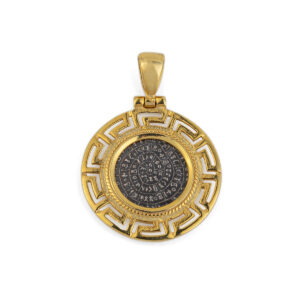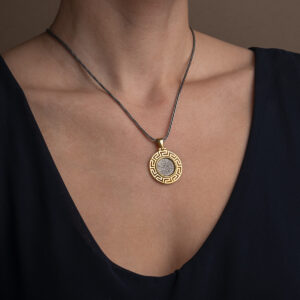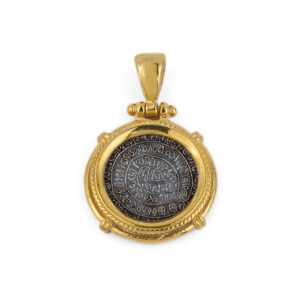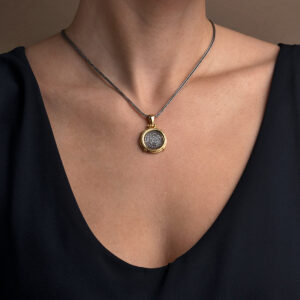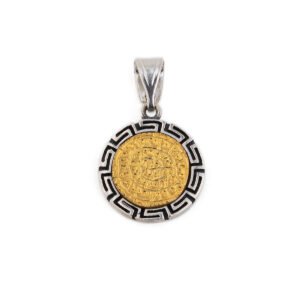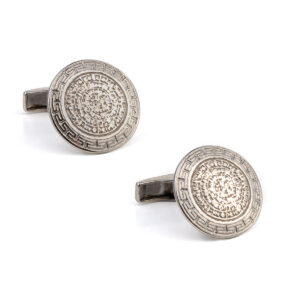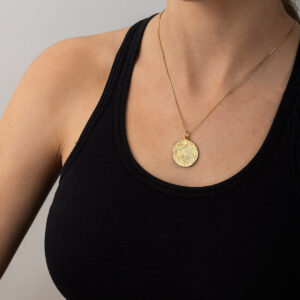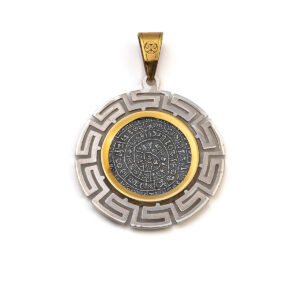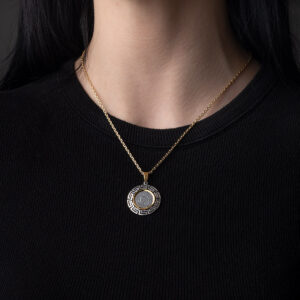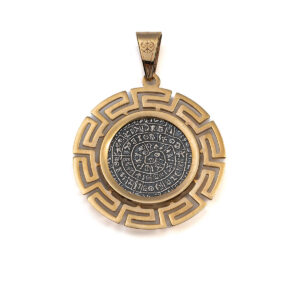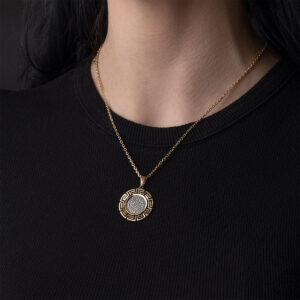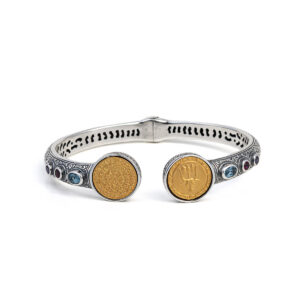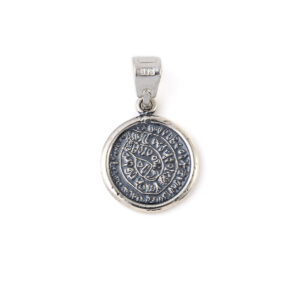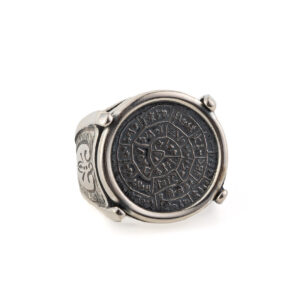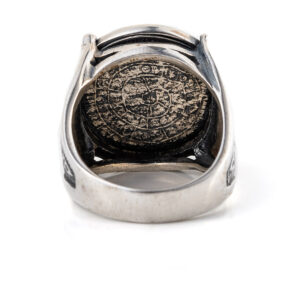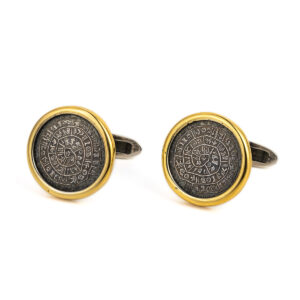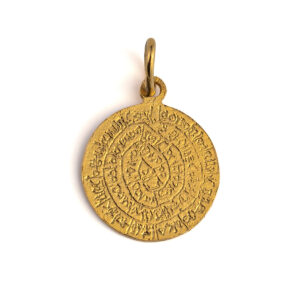The Phaistos Disc is a disk of fired clay from the Minoan palace of Phaistos on the island of Crete. Now, the island of Crete is part of modern Greece. The disc was discovered in 1908 by the Italian archaeologist Luigi Pernier in the Minoan palace-site of Phaistos. While it is not clear that it is a script, most attempted decipherments assume that it is; most additionally assume a syllabary, others an alphabet or logography or a calendar.
Greek Key Phaistos Disc Pendant – Sterling Silver and Gold Plated
Made of 925° sterling silver and gold plated.
Handmade item. Explore Phaistos Disc Collection
The Phaistos Disc is a disk of fired clay from the Minoan palace of Phaistos on the island of Crete. Now, the island of Crete is part of modern Greece. The disc was discovered in 1908 by the Italian archaeologist Luigi Pernier in the Minoan palace site of Phaistos. While it is not clear that it is a script, most attempted decipherments assume that it is; most additionally assume a syllabary, others an alphabet or logography or a calendar. The Malia honeybee pendant was discovered at Chryssolakkos, of the Minoan Palace of Malia on the island of Crete, and is thought to date to c.1800 BC. The named Chryssolakkos means the “pit of gold” because of the precious objects that the farmers used to find there. The Minoan Palace is situated 3 km east of Malia town and is the third most significant known Minoan Palace after Knossos and Phaistos. This pendant is in the shape of two bees, or wasps, storing away a drop of honey in a comb and is one of the most famous exhibits in the Heraklion Museum.
Phaistos Disc Pendant – Sterling Silver and Gold Plated
Made of 925° sterling silver and gold plated.
Handmade item. Explore Phaistos Disc Collection
The Phaistos Disc is a disk of fired clay from the Minoan palace of Phaistos on the island of Crete. Now, the island of Crete is part of modern Greece. The disc was discovered in 1908 by the Italian archaeologist Luigi Pernier in the Minoan palace site of Phaistos. While it is not clear that it is a script, most attempted decipherments assume that it is; most additionally assume a syllabary, others an alphabet or logography or a calendar. The Malia honeybee pendant was discovered at Chryssolakkos, of the Minoan Palace of Malia on the island of Crete, and is thought to date to c.1800 BC. The named Chryssolakkos means the “pit of gold” because of the precious objects that the farmers used to find there. The Minoan Palace is situated 3 km east of Malia town and is the third most significant known Minoan Palace after Knossos and Phaistos. This pendant is in the shape of two bees, or wasps, storing away a drop of honey in a comb and is one of the most famous exhibits in the Heraklion Museum.
Phaistos Disc and Minoan Bees Pendant – 925 Sterling Silver and Gold Plated
Made of 925° sterling silver and gold plated.
Handmade item. Explore Phaistos Disc Collection
The Phaistos Disc is a disk of fired clay from the Minoan palace of Phaistos on the island of Crete. Now, the island of Crete is part of modern Greece. The disc was discovered in 1908 by the Italian archaeologist Luigi Pernier in the Minoan palace site of Phaistos. While it is not clear that it is a script, most attempted decipherments assume that it is; most additionally assume a syllabary, others an alphabet or logography or a calendar. The Malia honeybee pendant was discovered at Chryssolakkos, of the Minoan Palace of Malia on the island of Crete, and is thought to date to c.1800 BC. The named Chryssolakkos means the “pit of gold” because of the precious objects that the farmers used to find there. The Minoan Palace is situated 3 km east of Malia town and is the third most significant known Minoan Palace after Knossos and Phaistos. This pendant is in the shape of two bees, or wasps, storing away a drop of honey in a comb and is one of the most famous exhibits in the Heraklion Museum.
Phaistos Disk Cufflinks – Sterling Silver
This beautiful pair of cufflinks represent the disc of Phaistos.
Made of 925 sterling silver.
Handmade in Greece.
Explore Phaistos Disc Collection
History
The Phaistos Disc is a disk of fired clay from the Minoan palace of Phaistos on the island of Crete. Now, the island of Crete is part of modern Greece. The disc was discovered in 1908 by the Italian archaeologist Luigi Pernier in the Minoan palace-site of Phaistos. While it is not clear that it is a script, most attempted decipherments assume that it is; most additionally assume a syllabary, others an alphabet or logography or a calendar, making it one of the most famous mysteries of archaeology. The disk is about 15 cm in diameter and covered on both sides with a spiral of stamped symbols. The disc features 241 tokens, comprising 45 distinct signs, which were apparently made by pressing hieroglyphic “seals” into a disc of soft clay, in a clockwise sequence spiraling toward the center of the disk. This unique object is now on display at the archaeological museum of Heraklion.
Phaistos Disk Cufflinks – Sterling Silver
This beautiful pair of cufflinks represent the disc of Phaistos.
Made of 925 sterling silver.
Handmade in Greece.
Explore Phaistos Disc Collection
History
The Phaistos Disc is a disk of fired clay from the Minoan palace of Phaistos on the island of Crete. Now, the island of Crete is part of modern Greece. The disc was discovered in 1908 by the Italian archaeologist Luigi Pernier in the Minoan palace-site of Phaistos. While it is not clear that it is a script, most attempted decipherments assume that it is; most additionally assume a syllabary, others an alphabet or logography or a calendar, making it one of the most famous mysteries of archaeology. The disk is about 15 cm in diameter and covered on both sides with a spiral of stamped symbols. The disc features 241 tokens, comprising 45 distinct signs, which were apparently made by pressing hieroglyphic “seals” into a disc of soft clay, in a clockwise sequence spiraling toward the center of the disk. This unique object is now on display at the archaeological museum of Heraklion.
Phaistos Disc Pendant 14k Gold
204,00€ – 850,00€A pendant inspired by the ancient disk found in Phaistos.
Made of 14k gold.
Handmade in Greece.
The chain shown is our 14K Gold Chain (not included).
Explore Phaistos Disc Collection
History
The Phaistos Disc is a disk of fired clay from the Minoan palace of Phaistos on the island of Crete. Now, the island of Crete is part of modern Greece. The disc was discovered in 1908 by the Italian archaeologist Luigi Pernier in the Minoan palace-site of Phaistos. While it is not clear that it is a script, most attempted decipherments assume that it is; most additionally assume a syllabary, others an alphabet or logography or a calendar.
Phaistos Disk Coin Pendant Meander Bezel
A pendant inspired by the ancient disk found in Phaistos.
Made of 925⁰ sterling silver and 14k gold.
Handmade in Greece.
The chain shown in the second picture is our Rollo Chain – 925 Sterling Silver and Gold Plated (included).
Explore Phaistos Disc Collection
History
The Phaistos Disc is a disk of fired clay from the Minoan palace of Phaistos on the island of Crete. Now, the island of Crete is part of modern Greece. The disc was discovered in 1908 by the Italian archaeologist Luigi Pernier in the Minoan palace-site of Phaistos. While it is not clear that it is a script, most attempted decipherments assume that it is; most additionally assume a syllabary, others an alphabet or logography or a calendar.
Phaistos Disk 14K Gold Coin Pendant Meander Bezel
A pendant inspired by the ancient disk found in Phaistos.
Made of 925⁰ sterling silver and 14k gold.
Handmade in Greece.
The chain shown in the second picture is our Rollo Chain – 14K Gold ( not included).
Explore Phaistos Disc Collection
History
The Phaistos Disc is a disk of fired clay from the Minoan palace of Phaistos on the island of Crete. Now, the island of Crete is part of modern Greece. The disc was discovered in 1908 by the Italian archaeologist Luigi Pernier in the Minoan palace-site of Phaistos. While it is not clear that it is a script, most attempted decipherments assume that it is; most additionally assume a syllabary, others an alphabet or logography or a calendar.
Phastos Disc Cuff Bracelet Sterling Silver Gold Plated
A bracelet inspired by the ancient disk found in Phaistos.
Made of 925⁰ sterling silver and gold plated.
Handmade in Greece.
Explore Phaistos Disc Collection
History
The Phaistos Disc is a disk of fired clay from the Minoan palace of Phaistos on the island of Crete. Now, the island of Crete is part of modern Greece. The disc was discovered in 1908 by the Italian archaeologist Luigi Pernier in the Minoan palace-site of Phaistos. While it is not clear that it is a script, most attempted decipherments assume that it is; most additionally assume a syllabary, others an alphabet or logography or a calendar.
In Greek mythology, the Minotaur is a mythical creature portrayed in Classical times with the head and tail of a bull and the body of a man. He dwelt at the center of the Labyrinth, which was an elaborate maze-like construction designed by the architect Daedalus and his son Icarus, on the command of King Minos of Crete. The Minotaur was eventually killed by the Athenian hero Theseus.
Labrys is, according to Plutarch, Minoan word for the double headed axe called in Greek πέλεκυς (pélekus). In ancient Crete, the double axe was an important sacred symbol of the Minoan religion. In Crete it never accompanies male gods, but always female goddesses. It seems that it associated with the worship of Mother Earth or Great Goddess.
Phaistos Disc Pendant – Sterling Silver 925
Phaistos Disc pendant. The Phaistos Disc is a disk of fired clay from the Minoan palace of Phaistos on the island of Crete. Now, the island of Crete is part of modern Greece. The disc was discovered in 1908 by the Italian archaeologist Luigi Pernier in the Minoan palace-site of Phaistos. While it is not clear that it is a script, most attempted decipherments assume that it is; most additionally assume a syllabary, others an alphabet or logography or a calendar.
Made in house in 925⁰ sterling silver.
Handmade item.
Phaistos Disc Cufflinks – 925 Sterling Silver
This beautiful pair of cufflinks representing the disc of Phaistos.
The Phaistos Disc is a disk of fired clay from the Minoan palace of Phaistos on the island of Crete. Now, the island of Crete is part of modern Greece. The disc was discovered in 1908 by the Italian archaeologist Luigi Pernier in the Minoan palace-site of Phaistos. While it is not clear that it is a script, most attempted decipherments assume that it is; most additionally assume a syllabary, others an alphabet or logography or a calendar, making it one of the most famous mysteries of archaeology. The disk is about 15 cm in diameter and covered on both sides with a spiral of stamped symbols. The disc features 241 tokens, comprising 45 distinct signs, which were apparently made by pressing hieroglyphic “seals” into a disc of soft clay, in a clockwise sequence spiraling toward the center of the disk. This unique object is now on display at the archaeological museum of Heraklion.
Made of 925 sterling silver
Handmade item.
Phaistos Disc Ring – 925 Sterling Silver
This beautiful ring represents the disc of Phaistos.
Handmade item.
Made of 925° sterling silver.
The Phaistos Disc is a disk of fired clay from the Minoan palace of Phaistos on the island of Crete. Now, the island of Crete is part of modern Greece. The disc was discovered in 1908 by the Italian archaeologist Luigi Pernier in the Minoan palace-site of Phaistos. While it is not clear that it is a script, most attempted decipherments assume that it is; most additionally assume a syllabary, others an alphabet or logography or a calendar, making it one of the most famous mysteries of archaeology. The disk is about 15 cm in diameter and covered on both sides with a spiral of stamped symbols. The disc features 241 tokens, comprising 45 distinct signs, which were apparently made by pressing hieroglyphic “seals” into a disc of soft clay, in a clockwise sequence spiraling toward the center of the disk. This unique object is now on display at the Archaeological Museum of Heraklion.
Phaistos Disc Cufflinks – 14K Gold and 925 Sterling Silver
This beautiful pair of cufflinks inspired by the ancient minoan phaistos disc.
Made in 925 sterling silver and 14k gold.
Handmade item. As in all handmade items there may be small differences in weight and dimensions and this is what makes them unique and precious.
The Phaistos Disc is a disk of fired clay from the Minoan palace of Phaistos on the island of Crete. Now, the island of Crete is part of modern Greece. The disc was discovered in 1908 by the Italian archaeologist Luigi Pernier in the Minoan palace-site of Phaistos. While it is not clear that it is a script, most attempted decipherments assume that it is; most additionally assume a syllabary, others an alphabet or logography or a calendar, making it one of the most famous mysteries of archaeology. The disk is about 15 cm in diameter and covered on both sides with a spiral of stamped symbols. The disc features 241 tokens, comprising 45 distinct signs, which were apparently made by pressing hieroglyphic “seals” into a disc of soft clay, in a clockwise sequence spiraling toward the center of the disk. This unique object is now on display at the archaeological museum of Heraklion.
Phaistos Disc Leather Bracelet – 925 Sterling Silver
This beautiful silver bracelet representing the disc of Phaistos.
This bracelet comes in a beautiful box.
Made in 925⁰ sterling silver.
Handmade item.
The Phaistos Disc is a disk of fired clay from the Minoan palace of Phaistos on the island of Crete. Now, the island of Crete is part of modern Greece. The disc was discovered in 1908 by the Italian archaeologist Luigi Pernier in the Minoan palace-site of Phaistos. While it is not clear that it is a script, most attempted decipherments assume that it is; most additionally assume a syllabary, others an alphabet or logography or a calendar.
Greek Phaistos Disc Cufflinks – Sterling Silver and Gold Plated
This beautiful pair of cufflinks representing the disc of Phaistos.
The Phaistos Disc is a disk of fired clay from the Minoan palace of Phaistos on the island of Crete. Now, the island of Crete is part of modern Greece. The disc was discovered in 1908 by the Italian archaeologist Luigi Pernier in the Minoan palace-site of Phaistos. While it is not clear that it is a script, most attempted decipherments assume that it is; most additionally assume a syllabary, others an alphabet or logography or a calendar, making it one of the most famous mysteries of archaeology. The disk is about 15 cm in diameter and covered on both sides with a spiral of stamped symbols. The disc features 241 tokens, comprising 45 distinct signs, which were apparently made by pressing hieroglyphic “seals” into a disc of soft clay, in a clockwise sequence spiraling toward the center of the disk. This unique object is now on display at the archaeological museum of Heraklion.
Made in 925 sterling silver and gold plated.
Handmade item.
Phaistos Disk Cufflinks – 925 Sterling Silver
This beautiful pair of cufflinks representing the disc of Phaistos.
The Phaistos Disc is a disk of fired clay from the Minoan palace of Phaistos on the island of Crete. Now, the island of Crete is part of modern Greece. The disc was discovered in 1908 by the Italian archaeologist Luigi Pernier in the Minoan palace-site of Phaistos. While it is not clear that it is a script, most attempted decipherments assume that it is; most additionally assume a syllabary, others an alphabet or logography or a calendar, making it one of the most famous mysteries of archaeology. The disk is about 15 cm in diameter and covered on both sides with a spiral of stamped symbols. The disc features 241 tokens, comprising 45 distinct signs, which were apparently made by pressing hieroglyphic “seals” into a disc of soft clay, in a clockwise sequence spiraling toward the center of the disk. This unique object is now on display at the archaeological museum of Heraklion.
Made of 925 sterling silver
Handmade item.
Minoan Phaistos Disc Pendant
Minoan Phaistos Disc Pendant. The Phaistos Disc is a disk of fired clay from the Minoan palace of Phaistos on the island of Crete. Now, the island of Crete is part of modern Greece. The disc was discovered in 1908 by the Italian archaeologist Luigi Pernier in the Minoan palace-site of Phaistos. While it is not clear that it is a script, most attempted decipherments assume that it is; most additionally assume a syllabary, others an alphabet or logography or a calendar.
Made in house in 925⁰ sterling silver.
Handmade item.
14k Gold Phaistos Disc Pendant
272,00€ – 510,00€Phaistos Disc Pendant in 14k Gold. The Phaistos Disc is a disk of fired clay from the Minoan palace of Phaistos on the island of Crete. Now, the island of Crete is part of modern Greece. The disc was discovered in 1908 by the Italian archaeologist Luigi Pernier in the Minoan palace-site of Phaistos. While it is not clear that it is a script, most attempted decipherments assume that it is; most additionally assume a syllabary, others an alphabet or logography or a calendar.
Handmade item.

